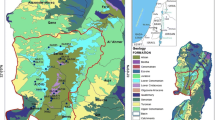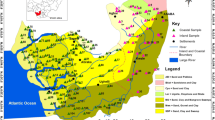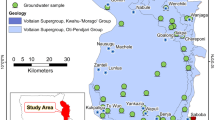Abstract
Douala city, located in the littoral province of Cameroon, receives abundant rainfall quantities due to its geographical position in the Gulf of Guinea and bears considerable surface water and groundwater resources. Due to socioeconomic development and rapid demographic growth in the city and its consequences of unplanned urbanization and improper sanitation system, these water resources are poorly protected and managed. Streams in the Wouri watershed receive large amounts of wastewater discharge, and hundreds of boreholes have been drilled into the aquifer system without any management plan. A detailed hydrodynamic and hydrogeochemistry study in Douala town and its environs was conducted to get a better insight into the groundwater system functioning in order to provide information for the sustainable management and protection of the groundwater resource. Two field campaigns were carried out with 187 samples collected and analyzed for major ions, stable isotopes (18O, 2H), and tritium 3H. The results of the sampling have shown that the weathering of silicate minerals is the dominant geochemical process affecting groundwater chemistry in this system. However, acid rainfall in the humid climate has also caused carbonate mineral dissolution, amorphous silica deposition, and ion exchange reactions to occur in aquifers in the region. The various water types identified were categorized into four major clusters C1 to C4, based on the major ion composition and the local hydrogeological conditions. Environmental isotope data reveal that modern-to-submodern waters occur in the phreatic Quaternary/Mio-Pliocene and Oligocene/Upper Eocene aquifers, respectively. These results corroborate with the conceptual model built where modern groundwater types indicated silicate mineral weathering and calcite dissolution (C1 and C2), whereas submodern groundwater mostly showed silica deposition, ion exchange, and, to a lesser extent, carbonate mineral dissolution (C3 and C4). This improved understanding of the aquifer system functioning is essential to provide a reasonable basis for effective control measures and sustainable water management.














Similar content being viewed by others
References
Adomako D, Osae S, Akiti TT, Faye S, Maloszewski P (2011) Geochemical and isotopic studies of groundwater conditions in the Densu River of Ghana. Environ Earth Sci 62:1071–1084
Appelo CAJ, Postma D (2005) Geochemistry, groundwater and pollution, 2nd edn. Taylor & Francis Group, Amsterdam, p 647
Aubert G, Segalen P (1966) Projets de classification des sols ferrallitiques. Cahiers Office de la Recherche Scientifique et technique Outre-Mer, série Pédologie IV
Clark I, Frirtz P (1997) Environmental isotopes in hydrogeology. Lewis Publishers, Boca Raton, p 328
Comte JC, Cassidy R, Obando J, Robins N, Ibrahim K, Melchioly S, Mjemah I, Shuri H, Bourhane A, Mohamed I, Noe C, Mwega B, Makokha M, Join JL, Banton O, Davies J (2016) Challenges in groundwater resource management in coastal aquifers of East Africa: investigations and lessons learnt in the Comoros Islands, Kenya and Tanzania. J Hydrol Reg Stud 5:179–199
Coplen TB (1988) Normalization of oxygen and hydrogen isotope data. Chem Geol 72:293–297
Das BK, Kakar YP, Moser H, Sticher W (1988) Deuterium and oxygen-18 studies in groundwater of the Dehli area, India. J Hydrol 98:133–146
Davis JC (2002) Statistics and data analysis in geology, 3rd edn. Wiley, New York
Din N (2001) Mangrove du Cameroun, statut écologique et perspectives de gestion durable. Thèse de Doctorat d’Etat es Sciences. Option Ecologie Végétale, Faculté des Sciences, Université de Yaoundé I, p 252
Dinka MO, Loiskandl W, Ndambuki JM (2015) Hydrochemical characterization of various surface water and groundwater resources available in Matahara areas, Fantalle Woreda of Oromiya region. J Hydrol Reg Stud 3:444–456
Djeuda THB, Tanawa E, Ngnikam E (2001) L’eau au Cameroun. Tome I: Approvisionnement en eau potable. Collection Connaissances des Presses Universitaires de Yaoundé, p 359
Drever JI (1988) The geochemistry of natural waters. Surface and groundwater environments. Prentice Hall, New Jersey, p 436
Dumort JD (1968) Notice explicative sur la feuille Douala-Ouest carte géologique de reconnaissance (1/500 000). Publication Direction des Mines et de la Géologie du Cameroun, p 69
Faye S (1991) Geochemical processes occurring in the unsaturated zone of a quaternary sandstone aquifer (Louga-Senegal), Master of Sciences thesis, University of Leeds, UK, p 103
Feumba R (2015) Hydrogéologie et évaluation de la vulnérabilité des nappes dans le bassin versant de Bessekè (Douala-Cameroun). Thèse de Doctorat PhD, Département de Sciences de la Terre, Faculté des Sciences. Université de Yaoundé I, p 226
Fontes JC (1980) Environmental isotopes in groundwater hydrology. In: Fritz P, Fontes JC (eds) Handbook of environmental isotope geochemistry. Elsevier, Amsterdam, pp 75–140
Fritz P, Hennings CS, Suzuki O, Salari E (1979) Isotope hydrology in northern Chile. In: Isotope hydrology (1978). IAEA, Vienna, pp 525–544
Garrels RM (1984) Montmorillonite/Illite stability diagrams. Clays Clay Miner 32(3):161–166
Gat JR (1981) Groundwater In: Gat JR, Gonfiantini R (eds) Stable isotopes in precipitation. The GNIP database, Release 3, Oct 1999. http://www.iaea.org/programs/ri/gnip/gnip-main.htm
Goldich SS (1938) A study in rock weathering. J Geol 46:17–56
Graig H (1961) Isotopic variations in meteoric waters. Science 133:1702–1703
Kamta Fotio GA (2000) Contribution à l’étude hydrogéologique du bassin de Douala: Essai de corrélation des niveaux captés dans l’aquifère quaternaire. Mémoire de maîtrise Université de Douala, p 36
Ketchemen TB (2011) Déterminants hydrogéologiques de la complexité du système aquifère du bassin sédimentaire de Douala (Cameroun). Thèse doctorat d’Etat, Faculté des Sciences et Techniques, Univ Cheick Anta Diop de Dakar, p 211
Kopa NKA, Likeng HDJ, Nono A (2012) Hydrodynamique et qualité des eaux souterraines dans le bassin sédimentaire de Douala (Cameroun): Cas des aquifères sur formations quaternaires et tertiaires. Int J Biol Chem Sci 6(4):1874–1894
Leontiadias IL, Payne BR, Christodoulou T (1988) Isotope hydrology of the Aghios Nikolaosarea of Crete, Greece. J Hydrol 98:121–132
Mafany GT (1999) Impact of the geology and seawater intrusion on groundwater quality in Douala. M.Sc. Thesis. Buea University Cameroon, p 100
Manga CS (2008) Stratigraphy, structures and prospectivity of the southern onshore Douala basin Cameroon-Central Africa. Cameroon and neighbouring basins in the Gulf of Guinea. Petroleum geology, tectonics, geophysics, paleontology and hydrogeology. Afri Geosci Rev Spec Publ 1–2:14–37
Martin G (1979) Alimentation en eau de la ville de Douala à partir des eaux souterraines. Etudes et travaux. Rapport BRGM, 79 AGE 021, p 145 + annexes
Mukherjee A, Saha D, Harvey CF, Taylor RG, Ahmed KM, Bhanja SN (2015) Groundwater systems of the Indian subcontinent. J Hydrol Reg Stud 4:1–14
Mvondo OF (2010) Surrection cénozoïque de l’Ouest de l’Afrique à partir de deux exemples: le plateau sud namibien la marge nord camerounaise. Thèse de Doctorat PhD, Université de Rennes 1, p 309
Ndomè EPE (2010) Minéralogie, géochimie et applications géotechniques des produits d’altération sur roches sédimentaires de Douala. Thèse de Doctorat PhD, Département des Sciences de la Terre, Faculté des Sciences, Université de Yaoundé I, p 210
Ndomè EPE, Onana VL, Boubacar L, Kamgang KBV, Ekodeck GE (2014) Relationships between major and trace elements during weathering processes in a sedimentary context: Implication for the nature of sources rocks in Douala, Littoral Cameroon. Chemie der Erde-Geochemistry, p 17
Ngo Boum NS, Ketchemen TB, Ndje Y, Emvoutou H, Ebonji CR, Huneau F (2015) Origin of mineralization of groungwater in the Bassa watershed (Douala-Cameroon). J Hydrogeol Hydrol Eng 4:1–9
Ngon Ngon G, Etamè J, Ntamak-Nida MJ, Mbesse CO, Mbai JS, Bayig EC, Gerard M (2016) Geochemical and paleoenvironmental characteristics of Missolè I iron duricrusts of the Douala sub-basin (Western Cameroon). CR Geosci 348:127–137
Njike NPR (2004) Palyno-stratigraphie et reconstitution des paléo-environnements du Crétacé de l’Est du bassin sédimentaire de Douala (Cameroun). Thèse de Doctorat d’Etat, Faculté des Sciences, Université de Yaoundé I, p 259
Nlend YB (2015) Signature isotopique des précipitations à Douala—Cameroun (Station GNIP Douala—HYDRAC, No 6491001). Département de Géologie. Faculté des Sciences. Université de Douala, p 46
Olivry JC (1986) Fleuves et rivières du Cameroun. Paris: Collection “Monographies hydrologiques ORSTOM”, p 781
Regnoult M (1986) Synthèse géologique du Cameroun. Ministère des Mines et de l’Energie du Cameroun. Yaoundé, p 119
Segalen P (1967) Altération des minéraux primaires, synthèse des minéraux secondaires au cours de la ferrallitisation. Les sols ferrallitiques. Cah ORSTOM Séri Péd 4(4):5–13
SNEC (1988) Rapport technique sur les forages de Massoumbou, Société Nationale des Eaux du Cameroun
Takem EG, Ayonghe SN, Thambidurai P (2009) Pollution characteristics of alluvial groundwater from springs and bore wells in semi-urban settlements of Douala, Cameroon, western Africa. Environ Earth 61:287–298
Takem EG, Chandrasekharam D, Ayonghe NS, Thambidurai P (2010) Pollution characteristics of alluvial groundwater from springs and bore wells in semi urban settlements of Douala, Caleroon, Westhern Africa. Environ Earth Sci 61:287–298
Takem GE, Kuitcha D, Ako AA, Mafany GT, Takounjou FA, Ndjama J, Ntchancho R, Ateba BH, Chandrasekharam D (2015) Acidification of shallow groundwater in the unconfined sandy aquifer of the city of Douala, Cameroon, Western Africa: implication four groundwater quality and use. Environ Earth Sci 74:6831–6846
Tamfu S, Batupe M (1995) Geologic setting, stratigraphy and hydrocarbon habitat of the Douala basin (Cameroon). Natl Hydrocarb J Cameroon 3:6
Tardy Y (1971) Characterization of the principal weathering types by the geochemistry of waters from some European and African crystalline massifs. Chem Geol 7:253–271
Tening AS, Chuyong GB, Azinwie AG, Ambo FB, Likowo LL, Ketchemen TB (2013) Nitrate and ammonium levels of some water bodies and their interaction with some selected properties of soils in Douala metropolis, Cameroon. Acad J AJEST 7:648–656
Thatcher LL, Janzer VJ, Edwards RW (1977) Methods for determination of radioactive substances in water and fluvial sediments. Techniques of water resources investigations of the US Geological Survey US Government Printing Office, Washington, pp 79–81
Trolard F, Tardy Y (1989) A model of Fe3+-kaolinite, Al3+-hematite, Al3+-hematite equilibria in laterites. Clays Miner 24(1):21
WHO (2006) Guidelines for drinking-water quality, third edition, volume 1—recommendations. World Health Organization, Geneva
Zogning A (1987) Les formations superficielles latéritiques dans la région de Douala: morphologie générale et sensibilité aux activités humaines. In : Séminaire régional sur les latérites : sols, matériaux, minerais : sessions 1 et 3. Paris: ORSTOM, pp 289–303
Acknowledgements
The first author is very grateful to the financial support from the French cooperation (SCAC) and UNESCO-ANESIVFW. She also thanks the UCAD hydrochemistry laboratory and the Institute of Groundwater Ecology (Helmholtz Zentrum München/Germany) for carrying out the analyses. She would like to thank Prof. Pape Malick NGOM, University Cheikh Anta Diop, Dakar, for reviewing this manuscript.
Author information
Authors and Affiliations
Corresponding author
Electronic supplementary material
Below is the link to the electronic supplementary material.
Rights and permissions
About this article
Cite this article
Emvoutou, H.C., Ketchemen Tandia, B., Ngo Boum Nkot, S. et al. Geologic factors controlling groundwater chemistry in the coastal aquifer system of Douala/Cameroon: implication for groundwater system functioning. Environ Earth Sci 77, 219 (2018). https://doi.org/10.1007/s12665-018-7400-z
Received:
Accepted:
Published:
DOI: https://doi.org/10.1007/s12665-018-7400-z




